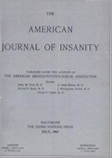A COMPARATIVE STUDY OF THINKING IN SCHIZOPHRENIC CHILDREN AND IN CHILDREN OF PRESCHOOL AGE
Abstract
An analogy is frequently drawn between schizophrenic and child thinking. In order to check the validity of such analogy, verbal productions from protocols of fifteen normal children of pre- school age (two to five years) and three schizophrenic children (with ages varying between seven years, ten months and fourteen years, seven months) are presented and compared. These productions were obtained under very similar conditions, i. e., favoring the spontaneous expression of phantasy, allowance being made for differences in ages, clinical needs and situational contingencies.
The systematic investigation of the phantasies of young normal children with regard to the evaluation of reality shows that responses fall within three categories: denial of character of reality, which is the most common type of response; evasion; and finally, reiteration with apparent belief. The latter category, containing the smallest number, includes those responses in which a strong emotional component is evident, chiefly fears, but also wishes. It is not possible to demonstrate in normal children true delusions and hallucinations or disorders characteristic of schizophrenic thinking. Experiences which come closest to these belong to the third category, i. e., reiteration with apparent belief, but are not appreciably different from similar experiences initiated in the adult by some strong emotional stimulus. It is recognized, however, that the child shows a greater emotional lability and greater susceptibility to somatic changes than the adult. In one instance where a confusion between reality and phantasy seemed apparent, the child showed emotional immaturity and a lack of social adaptation which point to a relation between the coincidence of such experience and a tendency toward faulty integration and adjustment in the future. Follow-up studies of the children's later adjustment should throw light on this point.
From the present records it appears evident that experiences which most closely resemble those found in the schizophrenic are dependent upon emotional factors and not upon characteristics inherent in child thinking.
Access content
To read the fulltext, please use one of the options below to sign in or purchase access.- Personal login
- Institutional Login
- Sign in via OpenAthens
- Register for access
-
Please login/register if you wish to pair your device and check access availability.
Not a subscriber?
PsychiatryOnline subscription options offer access to the DSM-5 library, books, journals, CME, and patient resources. This all-in-one virtual library provides psychiatrists and mental health professionals with key resources for diagnosis, treatment, research, and professional development.
Need more help? PsychiatryOnline Customer Service may be reached by emailing [email protected] or by calling 800-368-5777 (in the U.S.) or 703-907-7322 (outside the U.S.).



